Pep Guardiola and Jürgen Klopp are not just two of the most successful coaches of our time and currently the head coaches of the two probably best teams in the world, but also used their full-backs in a completely new way. Throughout history, wide-defenders were mainly the players with the worst technique which is also one of the reasons why Arrigo Sacchi developed a press in which you focus on forcing the opposition to play the ball to the full-back to then put pressure on him. This kind of high pressing is, until today, a commonly used pattern.
However, nowadays full-backs are often important parts of a team’s tactics and nowhere near the worst players of a team. The way that coaches use their wide-defenders differs from team to team. In this data analysis, we will use statistics to see if the way in which coaches use their full-backs becomes visible in their data.
Basic Idea
There are so many different tactics used in football, so many interesting teams and additionally several full-backs who play on a high level that have different tasks and interpret these differently. The basic idea behind this data analysis is to find out if the different roles of full-backs become visible in their in-game statistics.
For that, we will take a more detailed look at the data of the full-backs of the champions of the 2018/19 season in Europe’s top five leagues and additionally the UEFA Champions League winners. So, we have Liverpool, Manchester City, Juventus, PSG, Barcelona and Bayern Munich. To have other full-backs for comparison, we will look beside the wide-defenders of these six teams, also at the statistics of the full-backs of all teams in Europe’s top five leagues which have their preferred formation as one with a back four. Furthermore, I added the filter that all of these players must have played in the current season for at least 1015 minutes to be added to the pool.
All in all, with these filters I got a pool with 173 full-backs from all teams in Europe’s top five leagues who mainly play with a back four. In all of the graphs I also highlighted the full-backs of our six clubs, Trent Alexander-Arnold and Andrew Robertson for Liverpool; Benjamin Mendy and Kyle Walker for Man City; Alex Sandro and Juan Cuadrado for Juventus; Juan Bernat and Thomas Meunier for PSG; Jordi Alba, Sergi Roberto and Nélson Semedo for Barcelona; Joshua Kimmich, Benjamin Pavard and Alphonso Davies for Bayern Munich. Again, these are the full-backs who played in the current campaign at least 1015. Next, we will look at several statistics to see if we can see their different roles also in the metrics.
Passes per 90
To get a basic feeling how important the wide defenders are for their team’s tactics in possession, we will first look at the numbers of passes their team plays per game and additionally how many passes the full-backs make per game. At this stage, I also want to note that all stats which are used in this data analysis are the ones per 90 minutes. However, in the graph below we have the number of team passes and the passes per full-back.
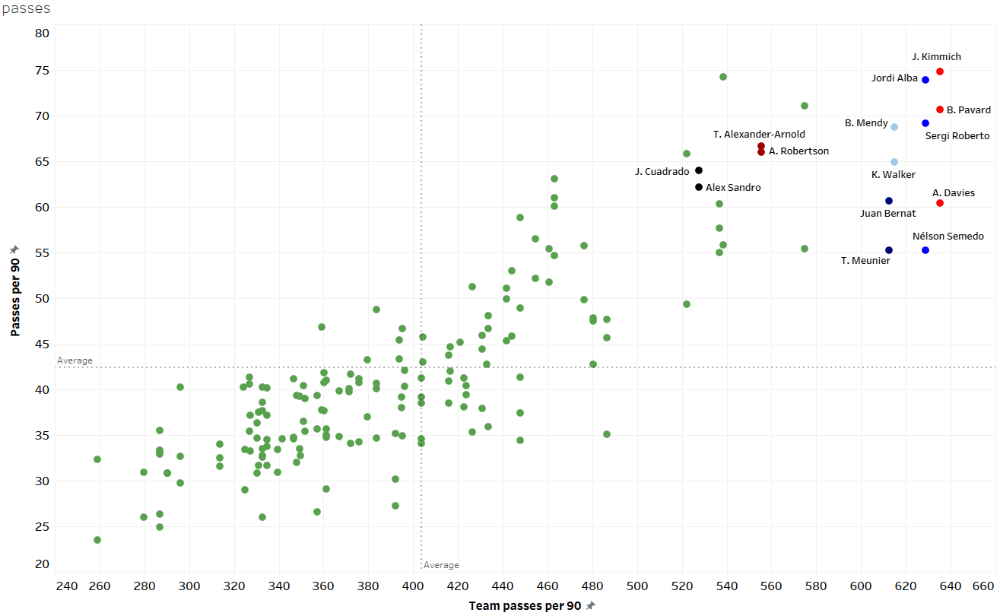
All six clubs are usually the dominant side with more possession and more passes than the opposition and this gets visible in the graph above. This is no surprise since all of them are either the dominant force in their league or among the very best teams. Anyways, still, we can see that Juventus (527.51) and Liverpool (555.55) don’t play as many passes as the other four teams. However, the number of passes of their full-backs is still higher than the values for Bernat and Meunier of PSG.
Meanwhile, Kimmich, Pavard, Alba and Roberto are the players with the most passes while Davies and Semedo don’t play that many passes even though they are regular starters for Bayern and Barcelona. While the Canadian wide defender prefers to rush forward with the ball at his feet which explains the low number of passes, Semedo often stays deeper while Alba goes forward. Even though Semedo’s understanding of the principles of positional play got better under Quique Setién, he still needs to work on that.
Mendy and Walker also have a high number of passes per 90 which is not such a surprise as Man City is the most dominant team of the EPL when it comes to passes and possession.
Passing types
Next, we will look at the types of passes which the wide-defenders play since just the number of passes doesn’t tell us much about the type of full-back and what tasks he has in his team’s tactics respectively. Due to that, we will now look at the long passes and forward passes.
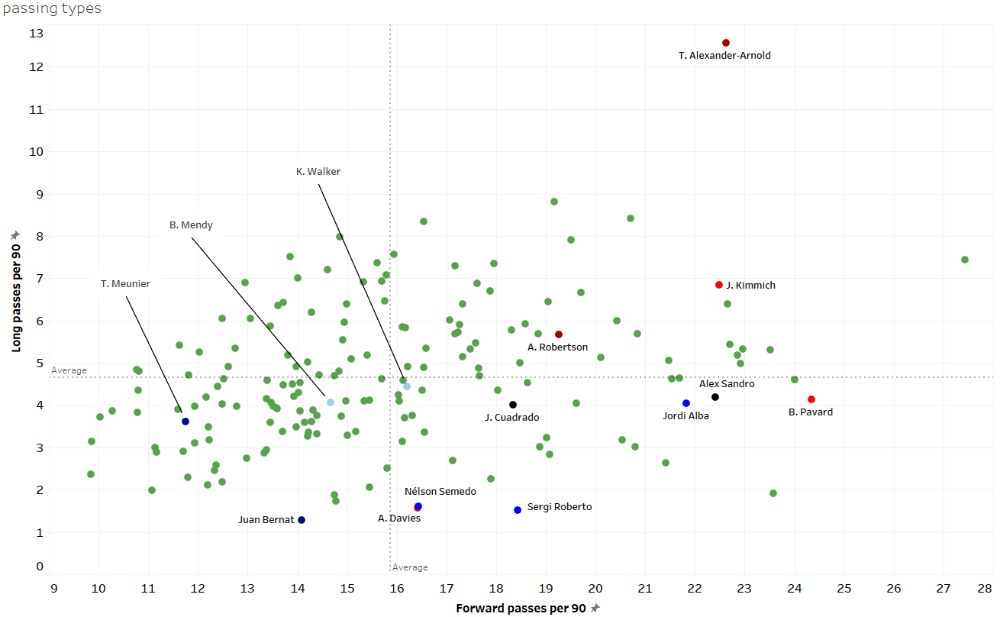
The player who instantly stands out is Alexander-Arnold due to his incredibly high number in both categories. He plays on average 12.57 long passes and 22.62 forward passes per game. These stats tell us why people often call him a full-back playmaker.
Meanwhile, the wide-defenders of PSG, Man City, Juventus and Barcelona have all a low number of long passes since their main approach is to reach the final third by using short passes while Bayern and Liverpool don’t hesitate to also play long balls.
The fact that Guardiola’s and Tuchel’s players have low numbers of forward passes too, is an indicator for their slow and patient progression of the ball. Also, we can see that especially Sandro, Alba, Kimmich and Pavard are important for the attacks of their teams due to their high number of forward passes.
Progressive actions
Now, as we have a basic overview of the passing types of the players and how many passes they play, I want to get to the progressive actions (progressive runs and progressive passes). These are interesting statistics to find out more about the player and which role they play within the manager’s tactics. The results are illustrated in the graph below.
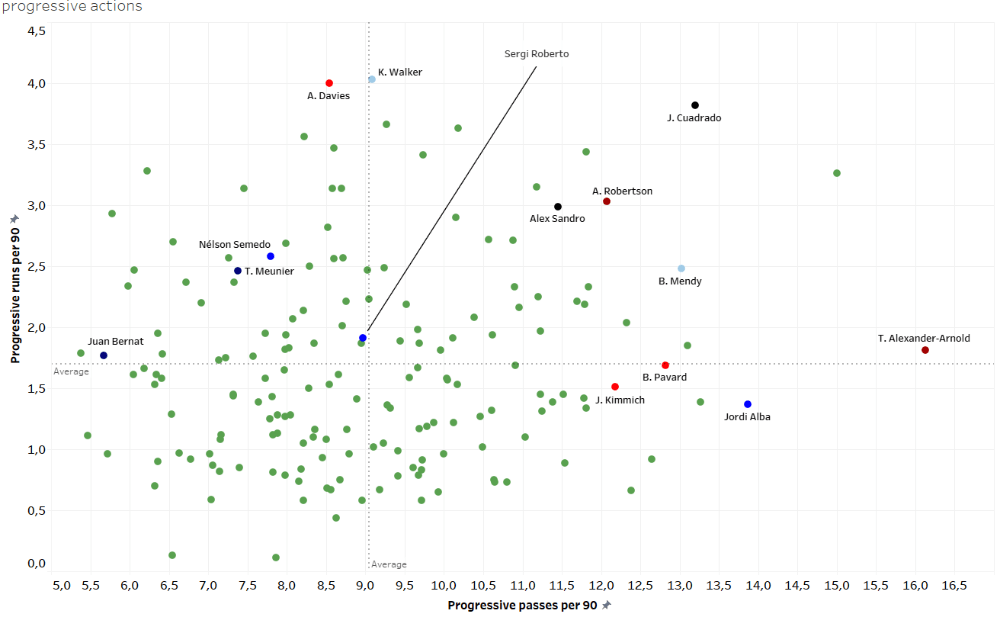
Again, Alexander-Arnold stands out due to his amazing passing statistics as he plays on average 16.13 progressive passes per game and it just approves again how important his passing skills are for Liverpool. Also, we can see the different roles of Robertson and Alexander-Arnold as the Scottish left-back has way more progressive runs (3.03) as he prefers to go forward with the ball at his feet while Klopp’s right-back is always looking for a vertical passing option.
Also, Sandro and Cuadrado have for both categories above-average values as they are offensive-minded full-backs. Furthermore, Since Maurizio Sarri mainly uses a 4-3-1-2 formation, they heavily rely on their wide-defenders to push forward, occupy the wings and support their teammates.
For Barcelona, Alba is the one with the most progressive passes (13.87), but only 1.37 progressive runs. The reason for that is that he had to fight with injuries in this season and, additionally, can’t rely anymore only on his pace due to the injuries and his age. However, Semedo especially likes to go forward by dribbling as he makes 2.58 progressive runs per game.
The players with the most progressive runs per game are Walker and Davies, who like to exploit their pace when they dribble forward. On the other side, Meunier and Bernat have low values for their progressive passes especially.
Crosses and deep completions
Next, we will look at two metrics which will tell us more about the activity of the wide-defenders in the final third and additionally how they act high up the pitch. Therefore, we will look at their numbers for crosses and deep completions (both per 90 minutes).
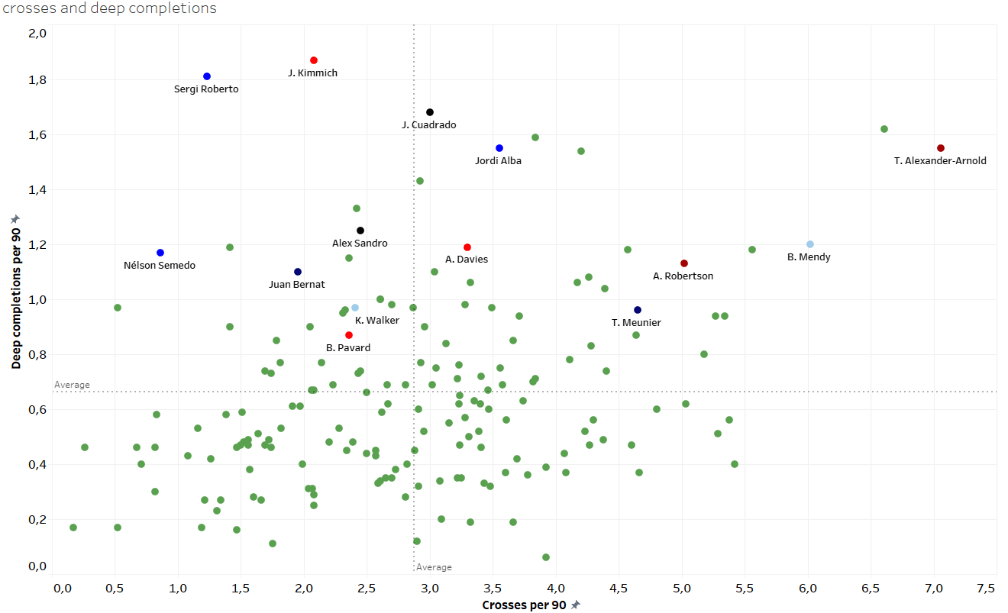
For Manchester City and PSG, we can see a huge difference between the two full-backs when it comes to the crosses. While Meunier and Mendy are two players who deliver a lot of crosses per game, Walker and Bernat clearly don’t. One reason for that (when we look at the Citizens) is that Walker often positions more centrally and deeper during the build-up while Mendy pushes forward and always stays near the touchline.
Liverpool’s wide-defenders have both high values for deep completions and crosses. We can explain that by looking at the Reds’ formation during possession. The full-backs have the freedom to push forward while the wingers tuck in and the central midfielders stay deeper which creates a kind of 3-2-5 (Fabinho as defensive midfielder drops between the centre-backs).
Bayern usually use crosses (22.96 per game and highest value in the Bundesliga), but especially the wingers are the one who sent them to the centre. Juventus and Barcelona are two teams who don’t cross that much, what is also an explanation, why the number of delivered crosses for their full-backs is quite low. However, as they try to create chances by using short passes and through passes, the value for deep completions of their full-backs are very high.
Expected assists and touches in the box
At this point, we already know quite a lot about the roles of the different full-backs at their respective clubs and also talked shortly about the tactics of the teams to understand the tasks of the wide-defenders. Now, we will look at two more graphs and four last statistics respectively. The next two metrics will be focusing on the players’ activity in the final third and the penalty box respectively as in the graph below we have the expected assists (xA) and the touches in the box.
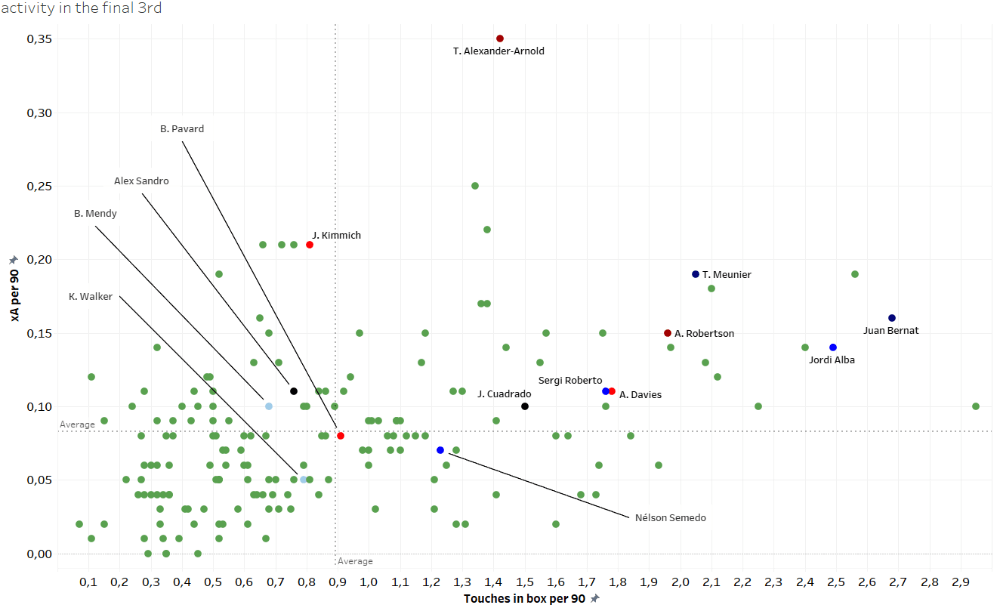
Again, Alexander-Arnold stands out due to a high value for xA (0.35) while all players of PSG and Barcelona have above-average values for their touches in the box. Mendy (0.68) and Walker (0.79) have a low number of touches in the opposition’s penalty area due to their already mentioned positioning. Mendy stays wide and hugs the touchline while his partner on the right side rarely pushes forward to join his teammates in the highest line.
When it comes to Bayern’s players, we can see again that Davies is the most offensive-minded of these four as he loves to overlap the left-winger and enter the penalty area (1.78 touches in the box). Also, the data shows that Cuadrado is a natural winger who wants to help his teammates in the higher lines and also can be found more frequently in the box (1.5 touches) compared to Sandro who usually stays wider (0.76 touches in the penalty area).
Defensive abilities
Even though full-backs have a lot of tasks during the attacking phase of their team nowadays, they are still part of the back four and therefore defenders which means that they need to have qualities in defensive duels, interceptions and so on. Due to that, in the last graph, we look at their numbers of defensive duels to see how many they are involved in and their successful defensive actions per 90 minutes.
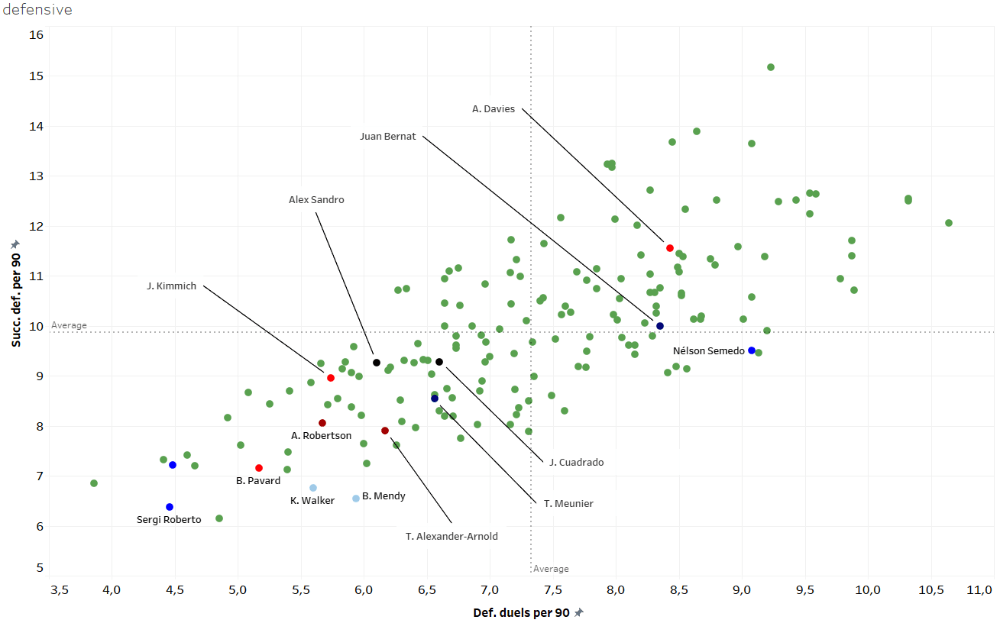
Without that much of a surprise, the majority of the full-backs of our six clubs are rarely involved in defensive duels and have a low number of successful defensive actions per 90 minutes since their side is usually the dominant one.
Anyways, one thing that stands out is that Davies, Bernat and Semedo are the only three full-backs of the 14 highlighted ones who are involved in an above-average number of defensive duels. The main reason for that is that their opponents try to attack down their side since they are the defensive weaker ones compared to the other wide-defenders in their squad (for Davies and Bernat) while Semedo is more defensive-minded compared to his teammates Roberto and Alba. Also, we can see that both Man City’s players have incredibly low numbers for successful defensive actions as they are such a dominant side.
Summary
We have now looked at six graphs and 12 statistics for 173 full-backs from five leagues to see if the way coaches use full-backs differently becomes visible in the data and we can definitely tell that this is the case. Considering this, I’ll now give a little summary for all six teams.
Liverpool: They are one of two teams of these six sides who don’t play that many passes, but their full-backs have still quite high values as they are so important for their team’s build-up. Furthermore, with Alexander-Arnold they have a full-back playmaker who is extremely strong when it comes to passes and crosses while Robertson prefers to rush down the wing with the ball at his feet. This gets visible in different stats as the left-back has a high number for progressive runs (3.03) while Alexander-Arnold plays more progressive passes (16.13) and delivers more crosses (7.06).
Manchester City: While Mendy mainly stays wide, we can sometimes see Walker as an inverted full-back. Because of this, both rarely enter the penalty box (0.68 and 0.79 touches in the penalty box), but Mendy often delivers one cross after another and Walker is impressive when it comes to progressive runs as he can perfectly exploit his pace when he starts from a deeper position with the ball at his feet. Additionally, their low numbers for forward passes and long balls perfectly show the patient and organised progression of Guardiola’s side.
Juventus: Juventus are not as possession-orientated as some other teams in this data analysis with an average value for possession of 57.9%. Still, Sandro (62.2) and Cuadrado (63.97) play a lot of passes per game and Sarri’s side heavily rely on them during the build-up. Furthermore, both men have high values for the categories progressive runs and progressive passes which shows us how important they are during the attacks for their team as they are in the often-used 4-3-1-2 the players who have the task to provide width.
PSG: Even though the team of Tuchel is in every game in the Ligue 1 the dominant team (on average 64.4% of possession), the two full-backs have not that high numbers for passes (55.22 and 60.67). According to the data, their wide-defenders aren’t that important for their build-up as they have a low number of progressive passes per 90 minutes. Also, while Meunier (whose contract expires this summer) delivers a lot of crosses (4.65 per 90 minutes), Bernat’s number is way lower with 1.95, but the Spaniard has more touches in the box (2.68).
Barcelona: Now, we come to the two teams for which three wide-defenders played in this season over 1015 minutes. We can see here some similarities, but also huge differences from player to player. Barcelona have on average 64.4% of possession and play 628.7 passes per game, but while Alba (73.89) and Roberto (69.17) have high values for passes, Semedo only plays on average 55.28 passes per 90 minutes. However, he has more progressive runs (2.58) compared to the two Spaniards. When it comes to the touches in the box, we can see that Semedo is the only one of the three who stays mainly deeper as he has the lowest value in this category.
Bayern: Kimmich played in this season not only as a right-back but also a lot as a central midfielder and due to that we will focus more on the statistics of Pavard and Davies. The greatest difference between these two gets visible when we look at the progressive actions. While Davies (natural winger) uses his pace to get past defenders and has the second-highest value for progressive runs of all players in our pool with four per game, Pavard (can also play as centre-back) is a good passer of the ball with 12.82 progressive passes per match. Also, Davies has more touches in the box (1.78) compared to Pavard (0.91) which is a good indicator which tells us that the Canadian is in general in a higher position compared to the right-back.
Conclusion
All in all, it was interesting to see how the different roles, strengths and weaknesses of the full-backs could be seen in the statistics. Of course, we could dive into several other metrics, but the data which was used in this analysis gave us a good overview. We saw not just the several roles of the wide-defenders which were from club to club different, but it also stood out that the majority of the teams used two types of wide-defenders and used them in different ways within the squad respectively.
In the next step, I will use data to find full-backs who could fit into these six top clubs and split it into several pieces. These recruitment analyses will be published in the upcoming weeks on Total Football Analysis.





Comments